Past Exhibition
Grounding; Grounded; Ground
Ara Koh considers how clay remembers, similarly to both the body and the landscape. Clay is able to record and recall the pressure of hands and fingers, the presence of moisture, as it surrenders to heat.…
On a recent visit to ceramicist Ara Koh’s studio, I observed a brief exchange between a deaf visitor, her translator, and the artist. The visitor wanted to know how a series of ceramic objects had been made. The forms were reminiscent of pool noodles or oversized pasta: the long cylinders, about the same diameter as a spice jar and longer than a human wingspan, were bent in loose loops, but rigid and upright. Buckets around the perimeter of the room held bunches of them, the way one might store kindling in preparation for making a fire. Koh explained her process of using a clay extruder, likening it to a sausage making machine—and the ASL translation included several signs that looked like what they described (the iconicity of sign language that is often mistaken as pantomime). The sign for machine leverages the knuckles to interlock like gears and show the beginning of a rotation, fingers enmeshed. Another sign seemed to delineate the contours of that which was being squeezed out: a C-like shape of the hand moving smoothly away from the body and repeated in series. As an outsider to this language, I recognized this extruded form in the air as both the clay and simultaneously the sausage. I had already heard the comparison in English, so this one gesture of the hand (what might have been a single precise word if I were fluent) contained the fullness of the metaphor—the mechanical precision, the squeezing of ground flesh into a predetermined shape, the extension and continuation of form, the hand that catches the flaccid line of matter as it bends under its own weight.
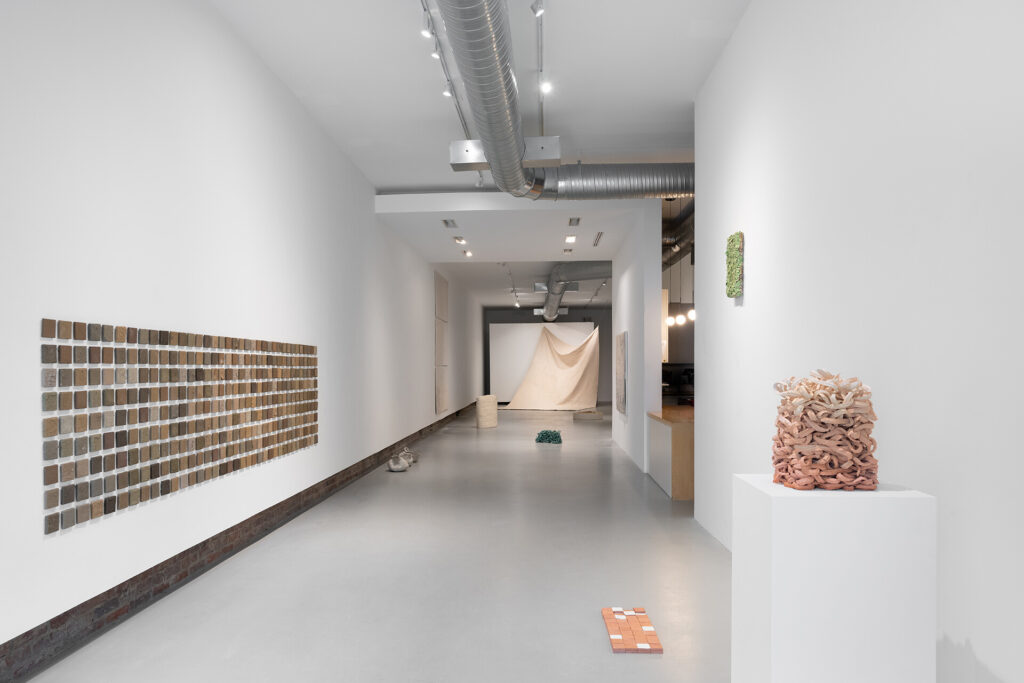
Though Koh’s work ostensibly has nothing to do with sign language, a chance encounter with this language of the hand can serve as a key for reading the body of new work that she presents in her solo exhibition Grounding; Grounded; Ground at Hamiltonian Artists. Indeed, Koh leaves her fingerprint, quite literally in the surfaces of many of her works. Diagonal strokes, the impression of a fingertip dragged through wet kaolin, fill the picture plane of six large canvases that comprise My fingers on your walls (2022). And each of the works in the Curls series consists of strands of clay pinched to create an undulating pattern, leaving a central ridge running down their lengths.

But the preoccupation here is not the self, or even the human, but rather the material of the clay. As a counterpoint to those surfaces that retain the human touch in their form, many of the other textures result from the particular circumstances that the artist constructs for the material. So many of Koh’s surfaces are dried and cracked due to application of wet clay on semiporous substrates such as stretched canvas, wood, and cloth. Careful viewing of the exhibition begins to develop one’s sensitivities to the variations in parched surfaces. And Koh’s use of the grid supports this inclination to compare.
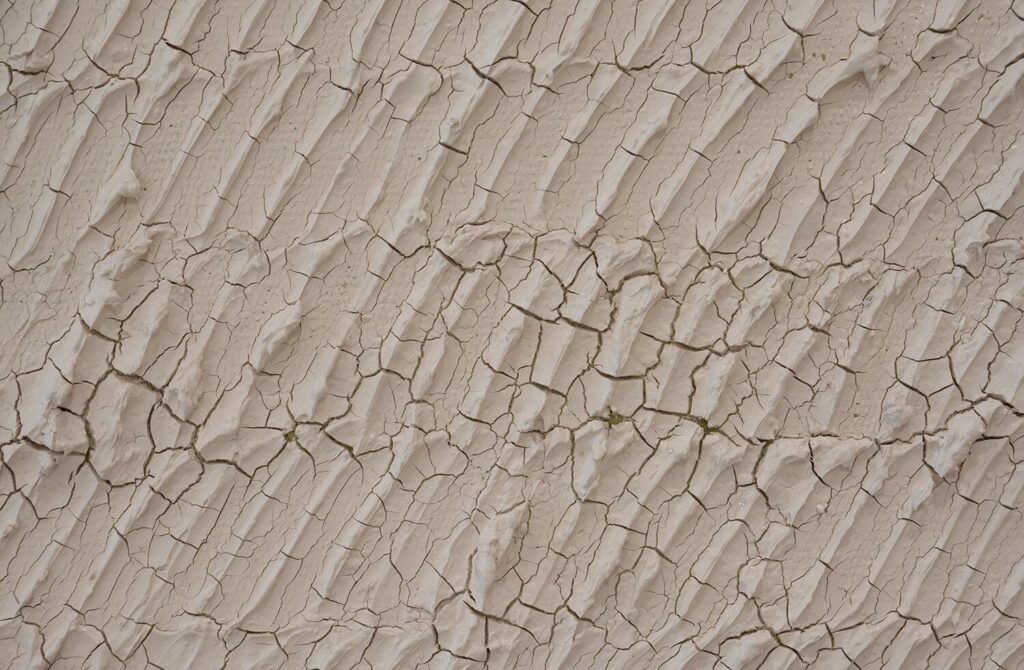
For the work Foot shades follow (2023), Koh collected 32 hyperlocal samples of clay from places she passed through during a three-month period when she was traveling between Virginia, Tennessee, and New York. She presents these different hand-foraged clays as the surfaces of over 300 small square canvases arranged as a patchwork of color and texture. The tonal shifts between the samples are striking, but more importantly we can start to see the different behaviors of the clays.
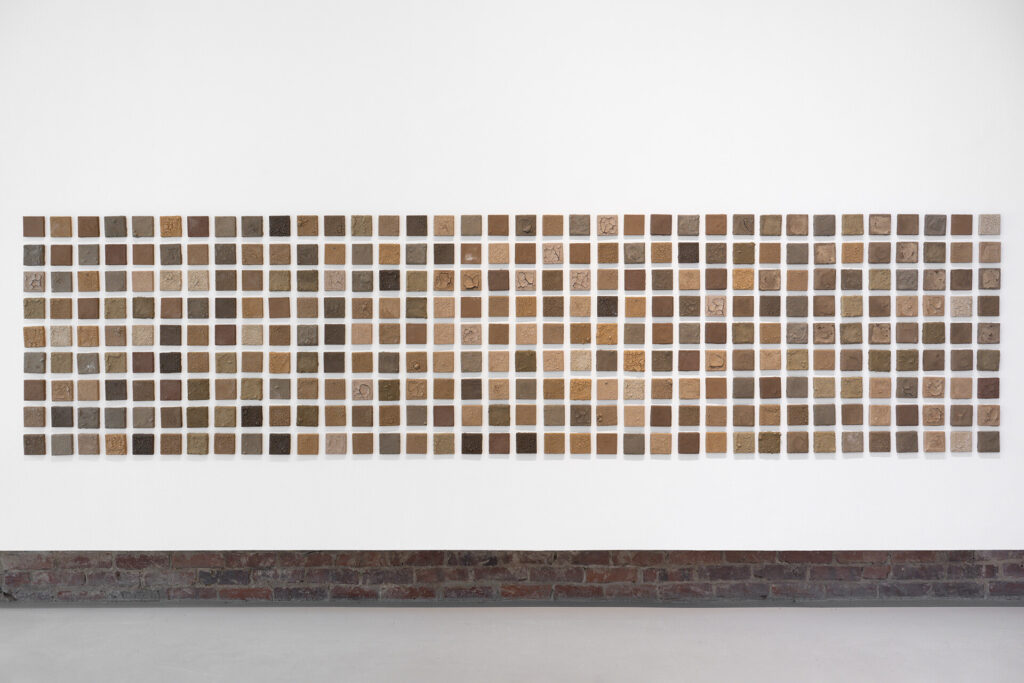
Some of these muds adhere closely to the underlying structure; their textures then proceed from the varying scales of the granular content. The way moisture evaporated from them results in a tautness. Other squares have more or less dramatic cracking, where shrinkage creates drawings in the negative spaces left between the contracting clay. In some of these squares, the clay is pulling away from the surface, peeling, or bubbling up. Each surface seems stable enough, not at risk of changing before our eyes, yet they are very much about time. In an astute presentation of process-based work, Koh has made a piece that is deeply indexical to wet clay. When reading the variations in texture, I find myself engaging not the current moment of the material, but a past instance, or perhaps its many possible pasts. These visceral squares activate my fingertips, my feet, even my mouth, as I consider their viscosity, their grit, their crunch, their slipperiness. Foot shades follow (2023) successfully addresses two of the artist’s stated goals: 1) to consider the human relationship to clay and 2) to explore the histories held in the clay.
The curation of the exhibition continues these inquiries by presenting an overview of clay’s uses and contexts. Koh has made vessels, domestic tiles, walls, ground, and towers. Different works employ different clays: terracotta—traditionally for brick; stoneware—for functional ceramics; kaolin—for porcelain; and the industrial production of products, such as paper, rubber, and paint. There is a mixture of fired, unfired, glazed, and unglazed. The precise placements of the work—a panel leaning on the wall by the front door, fired forms placed directly on the ground in the path of travel, a draped and suspended work, and wall pieces hung at waist level or all the way up towards to ceiling—asks that the viewer remember their own body in space and consider the materiality of everything around us.
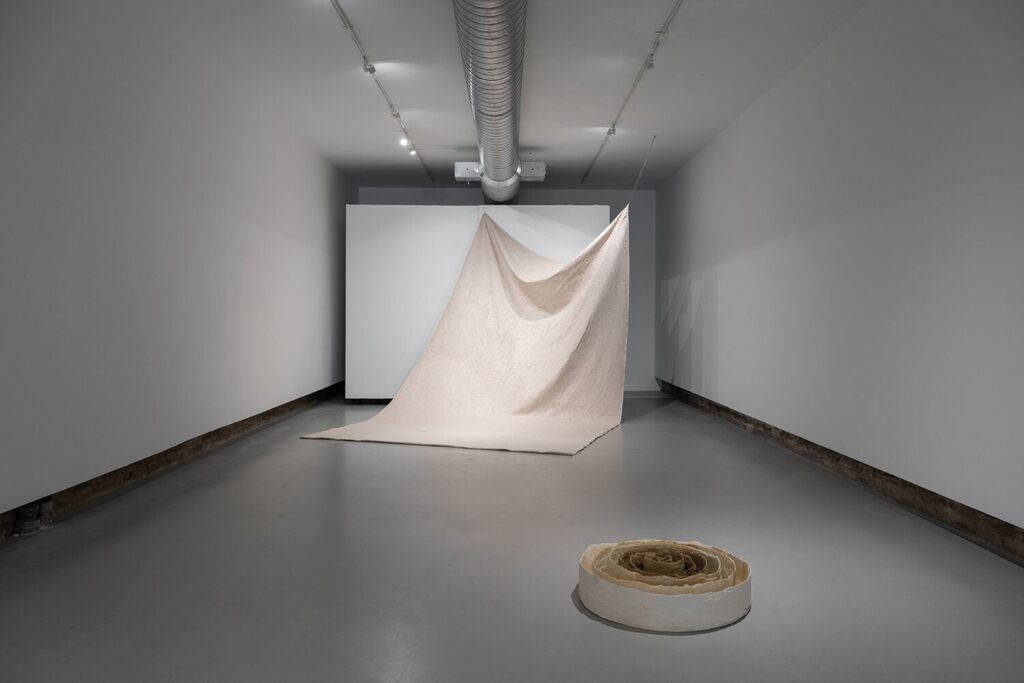
Together, these works outline the utilitarian histories of ceramics while maintaining a cohesive aesthetic of porous, raw surfaces and organic forms. The demonstrative quality of the individual works; the frequent use of the grid; and the references to industrial and architectural ceramics create an undercurrent of scientific and technological inquiry. But Koh’s work is not a critique of the taxonomical impulse, but rather a loving application. She uses systems, such as the grid, to guide our attention, and to say clay is worth closer examination. In this way, the exhibition avoids the cliched dichotomy between manmade vs natural. Instead, these artworks suggest a fluidity ourselves and the clay, an ancient dialogue, and a presence of both in everything.
Highly aware of my own ignorance to the histories and conventions of ceramics, I asked Koh what technical information might aid the viewer in making her work legible—what facts about clay types or firing temperatures might illuminate her forms and surfaces? Though the technicalities of ceramic production inform and even drive her practice, it’s not information that she expects her viewers to engage. Yet she did indulge my question by describing how she achieved the color transformation in GRADIENT CURLS (2023) by mixing different proportions of terracotta and stoneware, something that breaks the rules of proper pottery. She acknowledged that, because of the shifting ratios of the mixture, she had to fire the piece at a temperature too high for one, too low for the other, and pointed out the slumping and cracking of the terracotta at the base of the sculpture. However, Koh is more interested in drawing our attention to what she doesn’t know about the clay: “What plants lived and died in this earth, what dinosaurs lent their molecules to this clay, giving it a particular hue?”
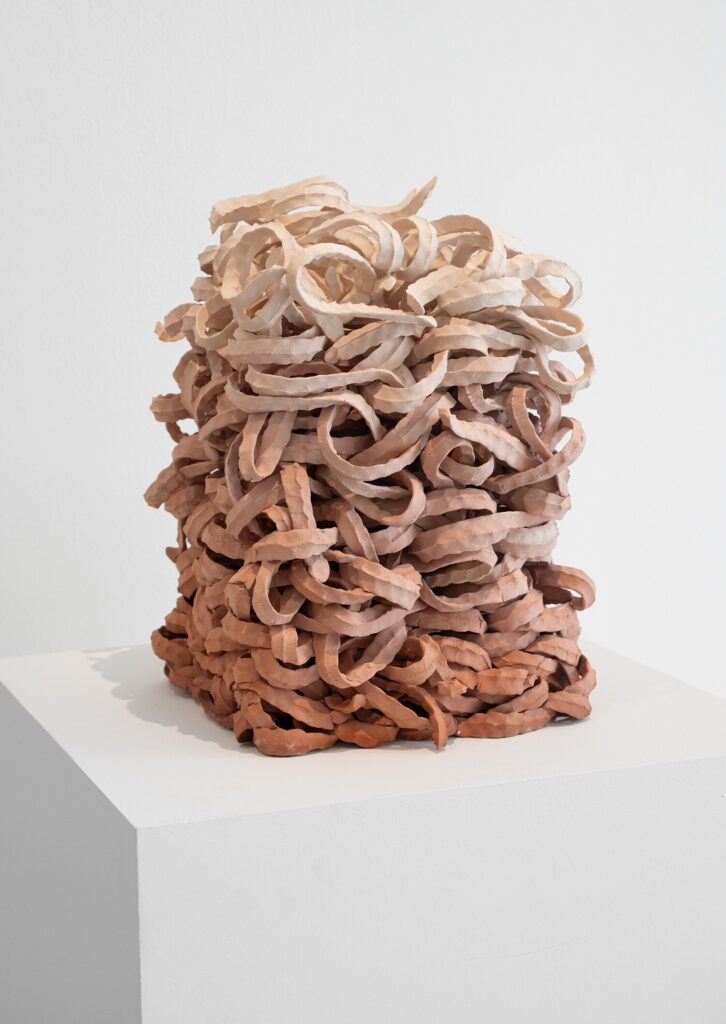
There is a scientific accuracy to this understanding of the material of clay, and a poetic resonance. Koh’s works express a material vitality, most prominently in the Curls series. As described at the beginning of this essay, each of these sculptures consists of finger-pressed strands of clay, that Koh has let curl and stack incidentally, following gravity and the process of squeezing along their lengths. The resulting form is almost a modular unit. They are like little buildings, teeming architectures. The ceramic lengths contained within each block are at once the twisted beams of a collapsed building (without the violence), and the intertwining vines of a growing plant (without the leaves). In fact, the ends of the strands reach like plant tendrils beyond the rectilinear boundary of the form, upturned ever so slightly toward the light. When I ran this idea by her, Koh insisted that this plantlike form was not deliberate, but she didn’t reject the association. It may be there, but it wasn’t her doing. This speaks volumes to the sensibility behind Koh’s practice, evident in this refined solo exhibition. Koh approaches clay with knowledge, respect, sensitivity, and a willingness to listen with her hands. Can we too learn to read these lessons spelled out in the clay?
Hannah Barco is the associate curator and festival director at Tephra Institute of Contemporary Art.
Past Exhibition
Ara Koh considers how clay remembers, similarly to both the body and the landscape. Clay is able to record and recall the pressure of hands and fingers, the presence of moisture, as it surrenders to heat.…